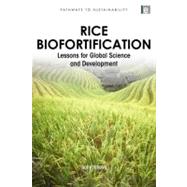
Note: Supplemental materials are not guaranteed with Rental or Used book purchases.
Purchase Benefits
What is included with this book?
| Abbreviations | p. ix |
| Acknowledgements | p. xiii |
| Introduction: Why Biofortification? | p. 1 |
| Global Science, Public Goods? | p. 3 |
| Biofortification as Biopolitics | p. 4 |
| Focus on Rice: Iconic Crop, Model Cereal | p. 5 |
| On Researching International Science Policy Processes | p. 7 |
| Chapter Preview | p. 12 |
| 'Old Lessons and New Paradigms': Locating Biofortification | p. 15 |
| International Crop Research and the CGIAR | p. 16 |
| Pathways Linking Agriculture, Nutrition and Health | p. 32 |
| 'Old Lessons and New Paradigms' | p. 40 |
| Building the Argument: The Case of Iron Rice | p. 43 |
| Introduction | p. 43 |
| A Win-Win Proposition: Nutrition and Yield | p. 44 |
| IR68144: 'A Serendipitous Discovery' | p. 48 |
| Iron Rice: The Silver Bullet? | p. 51 |
| Proof of Concept: The Sisters of Nutrition | p. 53 |
| From IR68144 to MS13: 'A Special Variety' | p. 59 |
| National Release: In the Shadow of Hybrid Rice | p. 63 |
| Conclusion | p. 66 |
| An Institutional Model? The Case of Golden Rice | p. 68 |
| Introduction | p. 68 |
| Rice Biotechnology: Laying the Foundations | p. 69 |
| Vitamin A Deficiency: Construction of a Public Health Problem | p. 71 |
| Golden Rice: A Scientific Breakthrough | p. 74 |
| A Science Policy Controversy | p. 76 |
| Granting Access, Keeping Control | p. 83 |
| Framing 'Acceptance': The Case of the Philippines | p. 88 |
| Conclusion | p. 91 |
| An Alliance Around an Idea: The Shifting Boundaries of HarvestPlus | p. 93 |
| Introduction | p. 93 |
| Back to Basics? A Challenge Program | p. 94 |
| A Turning Point: Enrolling the Gates Foundation | p. 100 |
| Establishing HarvestPlus | p. 105 |
| HarvestPlus Comes to IRRI | p. 107 |
| Interdisciplinary Encounters | p. 109 |
| Brokers or Gatekeepers? Organizational Tensions and 'Global Science' | p. 114 |
| Constructing Demand, Predicting Impact | p. 116 |
| Impact and 'Spin-Offs' | p. 119 |
| Business as Usual? The Pro VitaMinRice Consortium | p. 121 |
| Conclusion | p. 123 |
| Global Science, Public Goods? A Synthesis | p. 125 |
| International Research Partnerships: Rhetoric and Reality | p. 125 |
| Towards Interdisciplinary Integration? | p. 128 |
| De-linking Impact and Context | p. 130 |
| GM or Not GM - Is that the question? | p. 133 |
| Boundary Terms and 'Escape Hatches' | p. 135 |
| Conclusion | p. 138 |
| Locating and Engaging 'Users' | p. 140 |
| Rethinking Upstream-Downstream Relations | p. 141 |
| Towards a More Reflexive 'Public Goods' Science? | p. 141 |
| Notes | p. 143 |
| References | p. 157 |
| Index | p. 171 |
| Table of Contents provided by Ingram. All Rights Reserved. |
The New copy of this book will include any supplemental materials advertised. Please check the title of the book to determine if it should include any access cards, study guides, lab manuals, CDs, etc.
The Used, Rental and eBook copies of this book are not guaranteed to include any supplemental materials. Typically, only the book itself is included. This is true even if the title states it includes any access cards, study guides, lab manuals, CDs, etc.